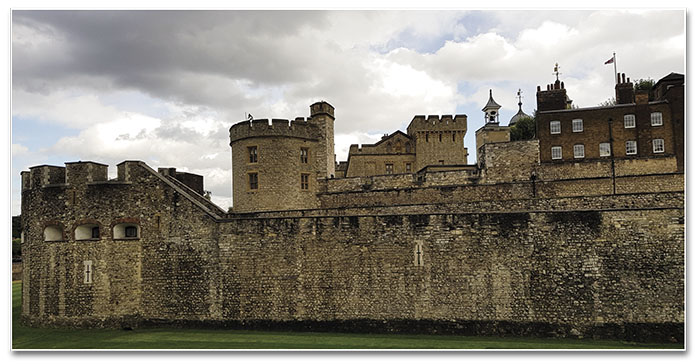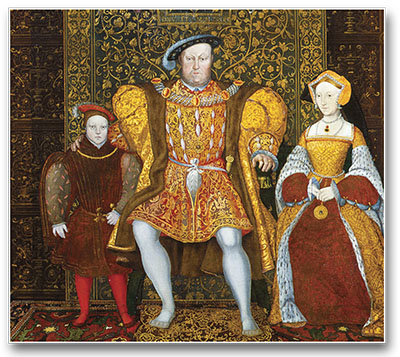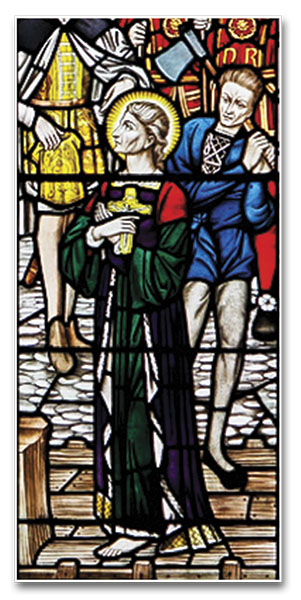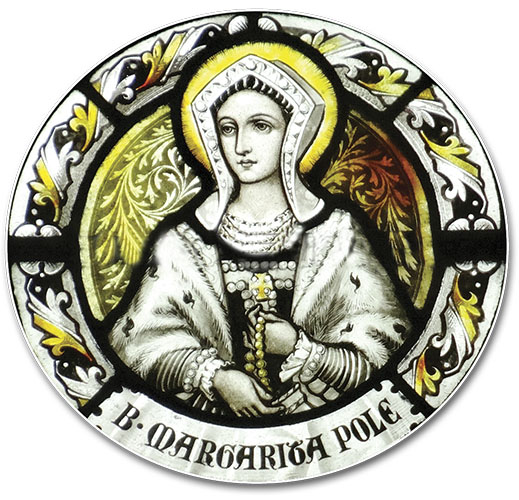At the break of dawn on May 27, 1541, the Countess of Salisbury was told that her last hour had come. Her long and unjust captivity in the dreaded Tower of London was over. In defense of her innocence, her sense of justice still led her to protest against King Henry’s cruelty. Nevertheless, her objections were ignored, and she went out with a firm and resolute step to the place of execution.
About one hundred and fifty people were gathered there to witness the gruesome spectacle. Without losing the composure stemming from her noble lineage nor the dignity befitting a white-haired septuagenarian, the prisoner, after commending her soul to God, knelt down on the crude wooden platform.
However, the executioner, an inexperienced and clumsy young man, unfit for such an office, struck the victim’s shoulders with his axe in a hideous manner, which only increased her final suffering. Lacerated by pain, the unfortunate lady instinctively arose and began to run around the platform, but was soon stopped. Finally, after repeated inept blows, her head was severed.
The shocking aspect of this account would naturally suggest that the condemned woman must have committed a particularly grave atrocity or some wicked treachery. However, there was no just reason for her condemnation… and perhaps this was the real reason for such violence.
After all, the worst punishments in the world are most often meted out not against crime, but innocence. The truth of this is borne out, among countless other examples, by the Passion and Death of the Innocent One, Jesus Christ, the unparalleled victim of the long history of human cruelty.
Thus, following in the divine footsteps of the Redeemer, this English martyr, Blessed Margaret Pole, was able to bear with grandeur of soul a dishonest persecution that had begun long before her murder.

The Tower of London
In the bosom of the royal house
Margaret Pole was born on August 14, 1473. She was the daughter of the Duke of Clarence, George Plantagenet – brother of Kings Edward IV and Richard III of England – and Elizabeth Neville, daughter of Earl Edmund Warwick, of the York lineage. Such ancestry made her a member of the old English royal house, being the last Plantagenet, for with her this dynasty, which reigned from 1154 to 1399, came to an end.
Due to the premature death of her parents, she was brought up with her cousins, the children of Edward IV. At twenty-one, she married Sir Richard Pole, with whom she had five children: Henry, Godfrey, Arthur, Reginald – who became a Cardinal, Papal Legate and later Archbishop of Canterbury – and Ursula. She raised them alone after being widowed in 1505.
In 1509, the then-young Henry VIII ascended the English throne in place of his late older brother, Arthur. Blood ties meant that he and Margaret were closely related. In fact, the future martyr was a first cousin to Elizabeth of York, the monarch’s mother.
For some time, the sovereign harbored noble sentiments towards her. He considered her the “holiest woman in his kingdom”1 and even restored possession of her family rights, which had been confiscated at the death of her brother Edward. In 1513, he made her Countess of Salisbury.
And as a token of even more affection and recognition, together with his wife Catherine of Aragon, he entrusted her with the education of his daughter, Princess Mary Tudor. The Countess was godmother at the Baptism and Confirmation of the girl who would one day be Queen of England and Ireland.
Now, although the sovereign’s heart seemed at first to be full of good intentions, he soon revealed himself to be proud and ambitious. Despite having fought for the interests of Holy Church against Protestantism and having received from the Supreme Pontiff the prestigious title of Defender of the Faith, he thought he had the right to bury the English nation in schism in order to justify his abject lust…
Categorical rejection of error
Indeed, corrupted by his evil passions, Henry VIII allowed himself to be seduced by Anne Boleyn, one of the ladies of the court. He then set about to find a way to annul his lawful marriage to Catherine of Aragon, on the pretext, among others, that she had failed to bear a male child to inherit the throne.
Since he met evident resistance from the ecclesiastical authorities, he officially proclaimed himself the sole head of the Church in England: the break with Rome had been declared. From then on, English history would be indelibly stained with the crimson blood of countless Catholics who dared to resist the king’s wanton immorality.
“Countess Margaret Pole,” for her part, “always regarded as a holy woman, of profound and deep-rooted faith, of great fortitude and accustomed to suffering,”2 faced this dreadful situation alongside Catherine of Aragon and Mary Tudor, submissive to the true Church and categorically rejecting the monarch’s follies.
The persecution begins

Henry VIII with his third wife Jane Seymour, and their son Edward – Hampton Court Palace (England)
Steadfast in her resolution to be faithful, Margaret became the target of Henry VIII’s enmity and hatred, not because she posed a threat to his perfidious interests, but because the mere presence of this noble and virtuous lady became the most persistent denunciation of his conduct.
The Book of Wisdom denounces with prophetic acuity the reasoning of the wicked when faced with integrity: “Let us lie in wait for the righteous man, because he is inconvenient to us and opposes our actions […]. He became to us a reproof of our thoughts; the very sight of him is a burden to us” (2: 12, 14-15). In fact, just as “every one who does evil hates the light” and seeks to destroy it “lest his deeds should be exposed” (Jn 3:20), so did the King of England with one whom he had previously claimed to love and honour as his own grandmother.
Not being able to do away with her at once as he wished, without arousing troublesome and noisy protests, Henry VIII proceeded with caution and discretion. His first blow was to remove her from her duties as governess and exclude her from the court in 1533. In so doing, he aimed to isolate Mary Tudor from Margaret’s influence, as he blamed her for the resistance he noted in the princess.
The separation was a cause of great suffering to both, who loved each other as mother and daughter.
Revenge against the Pole family
In 1536, after Anne Boleyn had been discarded by the king, Margaret was reincorporated into the court. However, Henry VIII’s fury against her had in no way diminished; on the contrary, it became even more exasperated when the monarch learned that Reginald Pole – son of the Countess and a staunch opponent of his actions – had been summoned to Rome to be made a Cardinal by Pope Paul III.
As if that were not enough, in 1540 the treatise Pro ecclesiaticæ unitatis defensione3 fell into the sovereign’s hands. It was authored by the Cardinal himself, and the fallacy of the king’s arguments was exposed. The king then decided to exact his full revenge on the Pole family.
Cardinal Pole, who had several years before moved to Italy because of his disagreement with the king, refused to return to English soil, and it was only by so doing that he escaped death. However, those closest to him were not so fortunate. On November 3, 1538, two of his brothers and some other relatives were imprisoned on charges of high treason. Their real crime, according to reports of the time, was that they were blood relatives of the Cardinal… All but one were killed after two months.
Even the most hardened hearts would find the torture inflicted on a mother whose son had been beheaded and several relatives killed more than sufficient. However, this was not so for the spiteful and voluptuous Henry, who was seeking further revenge.
On November 13, 1538, the courageous Countess was detained in her own home and subjected to exhaustive and tortuous interrogation. They hoped to find grounds to accuse her of fomenting popular uprisings against the Crown and of colluding with the revolutionary machinations of her children.
However, all the detractors could say was that “they had never seen or heard a woman so determined, so fearless and so clear in her gestures and words” and that her honest answers only allowed them to conclude two things: “Either her sons had never shared with her the secret of the conspiracy, or she was the most skilful traitor that had ever lived.”4
Condemned for her splendid innocence
In spite of this, the heroic Margaret had all her goods confiscated and was taken as a prisoner to Cowdray Park, where she was treated without the least civility. Her house, thoroughly searched for evidence, still attested to her innocence, for they found nothing that could serve to inculpate her.
They interrogated her again, and again were forced to acknowledge her virtue: “She seems to us more like a strong and firm man than a woman. In the face of all our attempts, she showed herself always honorable, courageous and upright.”5
She was forced to live in seclusion and isolation for months. At a certain point, an arbitrary sentence was passed that brought her ordeal to a head. During the months of May and June 1539, the House of Lords and the House of Commons sentenced sixteen people to death by a legislative act, without any previous trial or possibility of defence. It was an unmitigated abuse of power… And among its victims was the Countess of Salisbury.
What evidence was adduced against her? A white silk tunic, on which the five wounds were embroidered, a symbol that they deemed linked her to the so-called Pilgrimage of Grace, a protest movement against the schism of the English monarch, which involved nobles and common people. It was, moreover, thought to have been made by one of the accusers in order to condemn her.
On June 28, Margaret was transferred to the Tower of London to begin the last and most painful stage of her Calvary.
She spent almost two years in this prison, before her sentence was carried out, suffering the harshness of winter with inadequate clothing. The deprivation of almost every necessity prepared her soul, already so patient, for that fateful and glorious 27 of May, when, victim of the unjust hatred of a kingdom, she could present herself victorious and unblemished to the King of Heaven.
General outcry at her death

Blessed Margaret Pole – Church of Our Lady and the English Martyrs, Cambridge (England)
When her martyrdom was consummated in 1541, her mistreatment became the target of universal reproach. The French ambassador Marillac wrote to King Francis I that the episode was “more worthy of compassion than of long letters,” and commented: “The Countess of Salisbury was beheaded […] in the presence of so few people that until the evening people wondered whether it was true. […] The manner in which they proceeded in her case seems to indicate that they were afraid to kill her publicly, and so did it secretly.”6
Chappuys, Emperor Charles V’s ambassador, said that it was “the most strange and deplorable execution,” since she was “almost a septuagenarian, who in the natural course of things had not so long to live, and there was no reason that could justify her premature death.”7
Cardinal Pole, who was overcome with grief, also lamented: “The king had my mother beheaded for her constancy in the Catholic Faith, despite the fact that she was already seventy years old and was his closest relative, after his own children. This was the reward he saw fit to grant her for the care she had devoted to his daughter’s education and for the many years of service she had rendered him.”8
Recognition of her virtues
“Blessed are they who suffer persecution for the sake of righteousness” were the last words of this martyr. And they stand as a fitting definition of her life. In the words of one of her biographers, “she died an innocent victim of Henry VIII, never wavering a single instant in her refusal to confess to crimes she had never committed. […] Thus ends the singularly sorrowful life of the last direct descendant of a royal lineage in comparison with which the Tudors were merely beginners.”9
The Countess of Salisbury shone before God as a heroine, and her once-unknown fidelity was proclaimed to the whole world by the Supreme Pontiff in 1886 on the occasion of her beatification.
Integrity and indignation in opposition to evil!
The martyrdom of Blessed Margaret Pole is a wonderful example of integrity to be imitated. Faced with the insatiability of evil, manifested by the hatred of a corrupt king – unyielding, implacable and unforgiving, who knew neither pardon nor compassion; who inflicted death, destruction and dishonour; who took revenge on all and despised anyone who in word or deed opposed his goals – this fearless soul knew how to raise the standard of integrity, righteousness and the Catholic Faith.
Thus, the blood of this martyr, so generously offered, rises to Heaven as a prayer of noble dignity: “O that Thou wouldst slay the wicked, O God, and that men of blood would depart from me, men who maliciously defy Thee, who lift themselves up against Thee for evil! Do I not hate them that hate Thee, O Lord? And do I not loathe them that rise up against Thee? I hate them with perfect hatred; I count them my enemies” (Ps 139:19-22). ◊
Taken from the Heralds of the Gospel magazine, #175.
1 BIRON, Reginald; BARRENES, Jean. Reginald Pole. Un prince anglais, Cardinal-Légat au XVIᵉ siècle. Paris: Librairie Generale Catholique, 1922, p.152.
2 ECHEVERRÍA, Lamberto; LLORCA, SJ, Bernardino; REPETTO BETES, José Luis (Org.). Año Cristiano. Madrid: BAC, 2004, v.V, p.639.
3 From Latin: In Defence of the Unity of the Church.
4 BIRON; BARRENES, op. cit., p.142.
5 ECHEVERRÍA; LLORCA; REPETTO BETES, op. cit., p.642.
6 Idem, p.644-645.
7 BIRON; BARRENES, op. cit., p.154.
8 Idem, p.155.
9 Idem, p.154.

